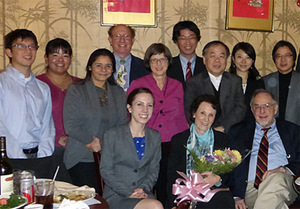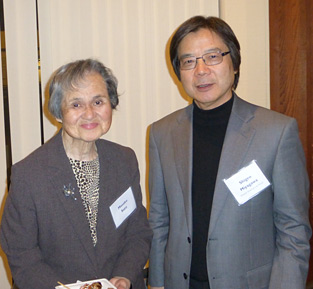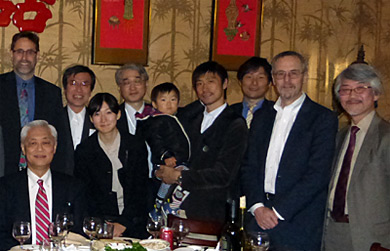
By Andrew Cohen
At a time when many countries are scrutinizing the role of legal education, Berkeley Law and one of its global partners convened to discuss emerging issues in the United States and Japan. The December 2013 Sho Sato Conference built on a longtime collaboration between the law school’s Sho Sato Program in Japanese and U.S. Law and Waseda University’s Institute of Clinical Legal Education in Tokyo.
The program is named in honor of the late Sho Sato, a distinguished Berkeley Law professor and prominent scholar of environmental, state, and local law.
“If you look at the problems facing legal education and the bar in both countries superficially, it looks like we’re dealing with the same challenges,” said Professor and Sho Sato Program Director Charles Weisselberg. “But when you look deeper, the differences are really profound, and I think this conference brought that out.”
Legal professionals in both nations share concerns about employment prospects for law school graduates and declining law school applications. And there are some longstanding debates between academia and the bar about how lawyers should be taught. But while many U.S. issues can be linked to the 2008 economic downturn and its impact on our legal marketplace, Japan faces more entrenched obstacles according to conference presenters.
U.S. and Japanese legal education experts shared information and—with the aid of interpreters providing translations of each presentation—offered wide-ranging suggestions.
“It’s important to understand differences in training and culture in our respective countries,” Weisselberg said. “But it’s also important to devise ways to deliver legal training and services effectively and efficiently while honoring our countries’ traditions.”
A bumpy beginning
As part of a series of reforms to its justice system, Japan opened 74 graduate professional law schools in 2004. But they are suffering a decline in applicants and a stagnant bar exam passage rate—just 26 percent. Meanwhile, legal services for rural residents, indigent clients, and small businesses remain elusive, said Japanese attorney Takuo Yamaguchi, vice chair of the Japan Federation of Bar Associations’ Center for Law Schools.

Law
School
Professor
Shigeo Miyagawa
Presenters described ongoing disagreement about what lawyers’ role should be, and noted that law schools are undermined because people in Japan can take the bar exam without obtaining a law degree. Other cited roadblocks: cultural aversion to litigation, a widespread view that hiring lawyers is not cost-efficient, and related professions that handle many non-litigation tasks lawyers could provide.
“In Japan, 60 percent of lawyers work in a solo practice,” Yamaguchi said. “Many lack the capacity or experience to provide great value.” Until 1990, Japan limited its number of new lawyers each year to 500. Since then, its lawyer pool has more than doubled: from 13,800 to about 32,000. “That has created a glut,” Yamaguchi explained. “There are globalization opportunities, such as negotiating contracts with foreign companies, but Japan hasn’t emphasized cross-border transactions in its training.”
Yamaguchi decried procedural hurdles that make it onerous to use Japan’s legal system, and a murky relationship between legal education and apprenticeships. “Schools still emphasize old-fashioned subjects that are not attuned to modern-day practice,” he added, “and there isn’t enough clinic work developing practical skills.”
Bridging the gap

Jeff Selbin, faculty director of the East Bay Community Law Center, discussed the juxtaposition of a difficult U.S. legal job market that leaves an estimated 80 percent of the poor’s civil legal needs unmet. He explained that while one in five Americans are eligible for free legal aid, half get turned away due to a lack of resources and capacity.
“Law schools must play a crucial role in bridging these gaps,” Selbin said, noting that clinics served about 90,000 clients last year, while stoking their students’ public-interest aspirations and skills. He urged law schools to “prioritize the demands of the poor, increase students’ experiential learning opportunities, expand post-graduate public interest opportunities, and partner with NGOs, bar associations, and government agencies.”
Kenji Fukuda and Sayaka Matsui—part of Waseda Law School’s first class when it opened in 2004—described their own gap-bridging work at the Waseda Legal Commons Law Office. Launched in March, the organization offers hands-on case experience to law school students and recent graduates.
“As the first generation of law school graduates in Japan, we feel an obligation to help our country’s new lawyers,” Fukuda said. Matsui called the nascent operation “a great opportunity to see where the law is applied and how it works in practice, while helping law students connect with legal professionals.”
Kristen Holmquist, the director of Berkeley Law’s Academic Support Program and associate director of its Professional Skills Program, described U.S. bar organizations’ push for schools to provide more practical training. State bars are considering mandating 50 or more hours of supervised pro bono experience, and the American Bar Association will likely adjust law school accreditation standards to require a minimum number of professional skills courses.
“Many law schools have already expanded their number of clinics, specialization certificates, externship opportunities, and adjunct-taught skills courses,” Holmquist said. “Experiential learning is certainly valued, but top students still gravitate to the highest-ranked schools and employers still value hiring from those schools over all other factors.”